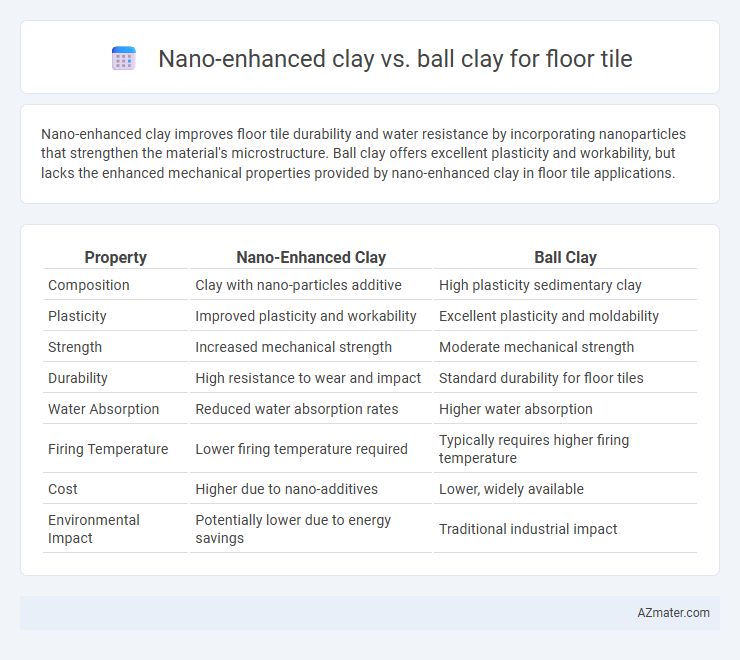Nano-enhanced clay improves floor tile durability and water resistance by incorporating nanoparticles that strengthen the material's microstructure. Ball clay offers excellent plasticity and workability, but lacks the enhanced mechanical properties provided by nano-enhanced clay in floor tile applications.
Table of Comparison
| Property | Nano-Enhanced Clay | Ball Clay |
|---|---|---|
| Composition | Clay with nano-particles additive | High plasticity sedimentary clay |
| Plasticity | Improved plasticity and workability | Excellent plasticity and moldability |
| Strength | Increased mechanical strength | Moderate mechanical strength |
| Durability | High resistance to wear and impact | Standard durability for floor tiles |
| Water Absorption | Reduced water absorption rates | Higher water absorption |
| Firing Temperature | Lower firing temperature required | Typically requires higher firing temperature |
| Cost | Higher due to nano-additives | Lower, widely available |
| Environmental Impact | Potentially lower due to energy savings | Traditional industrial impact |
Introduction to Floor Tile Materials
Floor tile materials vary significantly in composition, with nano-enhanced clay and ball clay being prominent options. Nano-enhanced clay incorporates nanoparticles to improve mechanical strength, water resistance, and durability, making it ideal for high-traffic areas. Ball clay, rich in kaolinite, offers excellent plasticity and workability, commonly used in traditional floor tile manufacturing for smooth surfaces and ease of molding.
What is Nano-Enhanced Clay?
Nano-enhanced clay incorporates nanoparticles that improve the mechanical strength, water absorption, and thermal resistance of floor tiles compared to traditional ball clay, which is primarily valued for its plasticity and fine-grained texture. The addition of nanoscale materials such as silica or alumina in nano-enhanced clay results in a denser microstructure, enhancing durability and reducing porosity. These advanced properties enable floor tiles made from nano-enhanced clay to offer superior performance in high-traffic areas and industrial applications over conventional ball clay-based tiles.
Understanding Ball Clay: Properties and Uses
Ball clay is a fine-grained, highly plastic sedimentary clay known for its excellent workability and strength, making it a crucial ingredient in floor tile manufacturing. Its low particle size distribution enhances the tile's smooth surface and improves mechanical properties such as flexural strength and fired density. Compared to nano-enhanced clay, ball clay provides natural plasticity and binding properties but lacks the advanced surface area and reactivity offered by nano-scale additives, which can significantly improve tile performance characteristics like wear resistance and durability.
Composition Differences: Nano-Enhanced Clay vs Ball Clay
Nano-enhanced clay incorporates nanoparticles such as silica or alumina, improving its physical properties like strength and durability, whereas ball clay primarily consists of fine-grained kaolinite and mica with high plasticity. The nanoscale additives in nano-enhanced clay enable enhanced bonding and reduced porosity in floor tiles, while ball clay's composition offers excellent workability but lower mechanical performance. These compositional distinctions influence tile quality, with nano-enhanced clay producing more resilient and wear-resistant floor surfaces compared to traditional ball clay tiles.
Mechanical Strength Comparison
Nano-enhanced clay demonstrates significantly higher mechanical strength compared to traditional ball clay in floor tile applications, due to the incorporation of nanoscale particles that improve particle bonding and reduce porosity. This enhancement results in superior flexural strength and increased resistance to wear and impact, making tiles more durable under heavy foot traffic. Ball clay, while offering good plasticity and workability, generally falls short in mechanical robustness, limiting its use in high-strength floor tile production.
Water Absorption and Porosity
Nano-enhanced clay significantly reduces water absorption and porosity in floor tiles due to its ultra-fine particle size and improved particle packing, resulting in denser, less permeable tiles. Ball clay, while offering good plasticity and strength, generally exhibits higher porosity and water absorption rates, making it less ideal for moisture-resistant flooring applications. The incorporation of nanomaterials in clay formulations enhances durability and moisture resistance, crucial factors for floor tile performance in wet environments.
Aesthetic Qualities and Surface Finish
Nano-enhanced clay offers significantly improved aesthetic qualities for floor tiles, delivering a smoother, more uniform surface finish with enhanced color vibrancy and depth due to the nanoscale particle distribution. Ball clay, while valued for its plasticity and molding properties, typically results in a coarser texture and less refined surface appearance, often requiring additional treatments for gloss and durability. The nano-enhanced clay's superior surface finish also contributes to greater resistance to surface blemishes and a more consistent gloss level, enhancing the overall aesthetic appeal of floor tiles.
Cost-Effectiveness and Production Efficiency
Nano-enhanced clay offers superior production efficiency in floor tile manufacturing due to its improved particle dispersion and enhanced mechanical properties, resulting in faster drying times and reduced waste. Ball clay, while more cost-effective in raw material price, often requires higher energy consumption and longer firing cycles, increasing overall production costs. Optimizing the balance between nano-enhanced clay's higher initial investment and ball clay's operational expenses can lead to significant cost savings in large-scale floor tile production.
Environmental Impact and Sustainability
Nano-enhanced clay for floor tiles reduces raw material consumption and lowers energy use during firing due to improved particle packing and sintering efficiency, leading to a smaller carbon footprint than traditional ball clay. Ball clay extraction often results in significant land disruption and water use, while nano-enhanced clay formulations allow for blending with recycled materials and industrial by-products, enhancing sustainability. The increased durability and reduced porosity of nano-enhanced clay tiles extend product lifespan, minimizing waste and environmental impact over time.
Choosing the Right Clay for Floor Tiles
Nano-enhanced clay offers superior strength, water resistance, and durability compared to traditional ball clay, making it ideal for high-traffic floor tiles. Ball clay provides excellent plasticity and smooth texture, enhancing workability but may fall short in mechanical performance under heavy wear. Selecting the right clay depends on balancing aesthetic qualities with functional performance requirements in floor tile manufacturing.

Infographic: Nano-enhanced clay vs Ball clay for Floor tile
 azmater.com
azmater.com